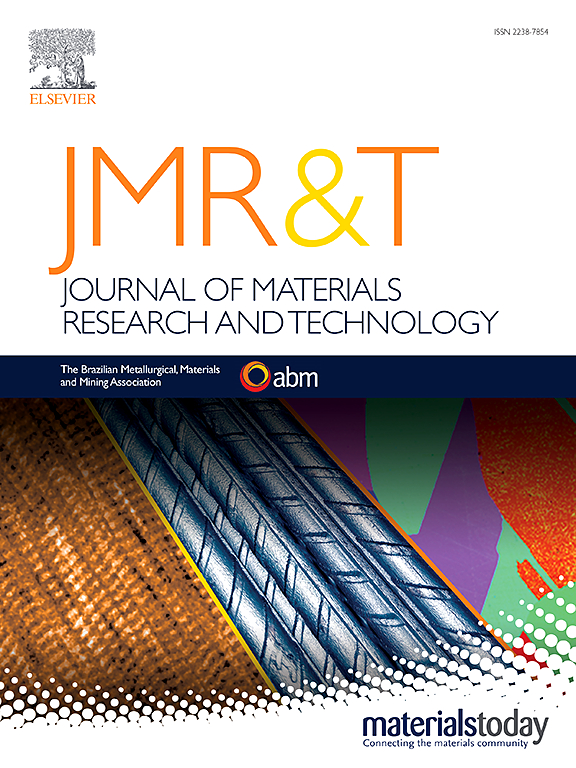UNS N08825镍基高温合金/UNS S32750超级双相不锈钢搅拌摩擦焊缝的显微组织演变、强度-塑性协同作用和腐蚀行为
IF 6.6
2区 材料科学
Q1 MATERIALS SCIENCE, MULTIDISCIPLINARY
Journal of Materials Research and Technology-Jmr&t
Pub Date : 2025-06-09
DOI:10.1016/j.jmrt.2025.06.064
引用次数: 0
摘要
镍基高温合金(nbs)和双相不锈钢的熔焊具有挑战性,因为难以达到最佳性能,主要是由于在焊缝中形成不平衡的相比和有害相。通过电子背散射衍射研究了UNS N08825 NBS和UNS S32750超级双相不锈钢(SDSS)搅拌摩擦焊件(FSW)各区域的组织演变。此外,还研究了拉伸性能、强化机制和腐蚀性能。结果表明,搅拌区不同再结晶机制的激活导致NBS区形成细晶奥氏体,SDSS区形成超细晶奥氏体和铁素体。在焊缝区域内还观察到NBS和SDSS的交替层。与SDSS(29%)和NBS(43%)母材相比,焊缝区的异质结构提高了加工硬化、强度,特别是伸长率(54%)。主要强化机制为SDSS侧的固溶强化(497 MPa)和NBS侧(190 ~ 266 MPa)及焊缝区(262 MPa)的晶界强化。此外,与NBS母材相比,焊缝区表现出更好的抗氧化膜性和抗点蚀性。总的来说,本研究表明,与贱金属相比,FSW是一种有效的技术,可以在SDSS SZ中保持相平衡,同时最大限度地减少有害相的形成,改善焊件的显微组织和性能。本文章由计算机程序翻译,如有差异,请以英文原文为准。
Microstructural evolution, strength-ductility synergy, and corrosion behavior of the UNS N08825 Ni-based superalloy/UNS S32750 super duplex stainless steel friction stir welds
Fusion welding of Ni-based superalloys (NBSs) and duplex stainless steels is challenging due to the difficulty of achieving optimal performance, primarily caused by the formation of an unbalanced phase ratio and detrimental phases in the weld. This research elucidates the microstructural evolution in various regions of the friction stir weldment (FSW) of UNS N08825 NBS and UNS S32750 super duplex stainless steel (SDSS) through an electron backscatter diffraction study. Additionally, the tensile behavior, strengthening mechanisms, and corrosion properties were examined. The results reveal that the activation of distinct recrystallization mechanisms in the stir zones (SZs) led to the formation of fine-grained austenite in the NBS SZ and ultrafine-grained austenite and ferrite in the SDSS SZ. Alternating layers of NBS and SDSS were also observed within the weld zone. This heterostructure in the weld zone led to an enhancement in the work hardening, strength, and particularly elongation (54 %) compared to the SDSS (29 %) and NBS (43 %) base metals. The primary strengthening mechanism was identified as solid solution strengthening on the SDSS side (497 MPa) and grain boundary strengthening on the NBS side (190–266 MPa) and in the weld zone (262 MPa). Moreover, the weld zone exhibited superior oxide film resistance and enhanced pitting corrosion resistance relative to the NBS base metal. Overall, this research demonstrates that FSW is an effective technique for maintaining the phase balance in the SDSS SZ while minimizing the formation of detrimental phases and improving the microstructure and properties of the weldment compared to the base metals.
求助全文
通过发布文献求助,成功后即可免费获取论文全文。
去求助
来源期刊

Journal of Materials Research and Technology-Jmr&t
Materials Science-Metals and Alloys
CiteScore
8.80
自引率
9.40%
发文量
1877
审稿时长
35 days
期刊介绍:
The Journal of Materials Research and Technology is a publication of ABM - Brazilian Metallurgical, Materials and Mining Association - and publishes four issues per year also with a free version online (www.jmrt.com.br). The journal provides an international medium for the publication of theoretical and experimental studies related to Metallurgy, Materials and Minerals research and technology. Appropriate submissions to the Journal of Materials Research and Technology should include scientific and/or engineering factors which affect processes and products in the Metallurgy, Materials and Mining areas.
 求助内容:
求助内容: 应助结果提醒方式:
应助结果提醒方式:


